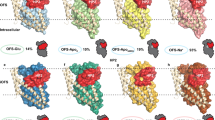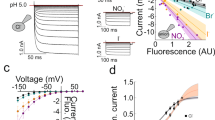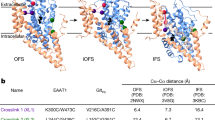Abstract
Arachidonic acid modulates both electrical and biochemical properties of membrane proteins involved in cellular signaling. In Xenopus laevis oocytes expressing the excitatory amino acid transporter EAAT4, physiologically relevant concentrations of arachidonic acid increase the amplitude of the substrate-activated current by roughly twofold at -60 mV. This stimulation is not attributable to the modulation of either substrate/ion cotransport or the ligand-gated chloride current, the major conductance associated with this carrier. Ion-substitution experiments reveal that arachidonic acid stimulates a proton-selective conductance. The effect does not require metabolism of arachidonic acid and is not blocked by inhibitors of endogenous oocyte ion-exchangers. This proton conductance expands the complex repertoire of the ligand-gated channel properties associated with EAAT4.
This is a preview of subscription content, access via your institution
Access options
Subscribe to this journal
Receive 12 print issues and online access
$209.00 per year
only $17.42 per issue
Buy this article
- Purchase on Springer Link
- Instant access to full article PDF
Prices may be subject to local taxes which are calculated during checkout







Similar content being viewed by others
References
Arriza, J.L. et al. Functional comparisons of three glutamate transporter subtypes cloned from human motor cortex. J. Neurosci. 14, 5559 –5569 (1994)
Fairman W.A., Vandenberg R.J., Arriza J.L., Kavanaugh, M.P. & Amara S.G. An excitatory amino-acid transporter with properties of a ligand-gated chloride channel. Nature 375, 599–603 (1995)
Arriza, J.L., Eliasof, S., Kavanaugh, M.P. & Amara, S.G. Excitatory amino acid transporter 5, a retinal glutamate transporter coupled to a chloride conductance. Proc. Natl Acad. Sci. USA 94, 4155–4160 (1997)
Kanai, Y. Family of neutral and acidic amino acid transporters: molecular biology, physiology and medical implications. Curr. Opin. Cell Biol. 9, 565–572 (1997)
Sonders, M.S. & Amara, S.G. Channels in transporters. Curr. Opin. Neurobiol. 6, 294–302 (1996)
Kanai, Y. et al. Electrogenic properties of the epithelial and neuronal high affinity glutamate transporter J. Biol. Chem. 270, 16561– 16568 (1995)
Zerangue, N. & Kavanaugh, M.P. Flux coupling in a neuronal glutamate transporter. Nature 383, 634– 637 (1996)
Barbour B., Brew, H. & Attwell, D. Electrogenic glutamate uptake in glial cells is activated by intracellular potassium. Nature 335, 433– 435 (1988)
Takahashi, M. et al. The role of glutamate transporters in glutamate homeostasis in the brain. J. Exp. Biol. 200, 401–409 (1997)
Lester, H.A., Cao, Y. & Mager, S. Listening to neurotransmitter transporters. Neuron 17, 807–810 (1996)
Wadiche, J.I., Amara, S.G. & Kavanaugh, M.P. Ion fluxes associated with excitatory amino acid transport . Neuron 15, 721–728 (1995)
Yamada, K. et al. EAAT4 is a postsynaptic glutamate transporter at purkinje cell synapses. Neuroreport 7, 2013–2017 (1996)
Tanaka, J., Ichikawa, R., Watanabe, M., Tanaka, K. & Inoue, Y. Extra-junctional localization of glutamate transporter EAAT4 at excitatory Purkinje cell synapses. Neuroreport 8, 2461–2464 (1997)
Otis, T.S., Kavanaugh, M.P. & Jahr, C.E. Postsynaptic glutamate transport at the climbing fiber–purkinje cell synapse. Science 277, 1515– 1518 (1997)
Barbour, B., Keller, B.U., Llano, I. & Marty, A. Prolonged presence of glutamate during excitatory synaptic transmission to cerebellar Purkinje cells. Neuron 12, 1331– 43 (1994)
Takahashi, M., Kovalchuk, Y. & Attwell, D. Pre- and postsynaptic determinants of EPSC waveform at cerebellar climbing fiber and parallel fiber to purkinje cell synapses. J. Neurosci. 15, 5693–5702 ( 1995)
Piomelli, D. Arachidonic acid in cell signaling. Curr. Opin. Cell Biol. 5, 274–280, (1993)
Piomelli, D. & Greengard, P. Lipoxygenase metabolites of arachidonic acid in neuronal transmembrane signalling. Trends Pharmacol. Sci. 11, 367–373 ( 1990)
Ordway, R.W., Singer, J.J. & Walsh, J.V. Jr. Direct regulation of ion channels by fatty acids. Trends Neurosci. 14, 96–100 (1991)
Volterra, A. et al. A role for the arachidonic acid cascade in fast synaptic modulation: ion channels and transmitter uptake systems as target proteins. Adv. Exp. Med. Biol. 318, 147–158 ( 1992)
Attwell, D., Miller, B. & Sarantis, M. Arachidonic acid as a messenger in the central nervous system. The Neurosciences 5, 159–169 (1993)
Gegelashvili, G. & Schousboe, A. High affinity glutamate transporters: regulation of expression and activity. Mol. Pharmacol. 52, 6–15 (1997)
Dumuis, A., Pin, J.P., Oomagari, K., Sebben, M. & Bockaert, J. Arachidonic acid released from striatal neurons by joint stimulation of ionotropic and metabotropic quisqualate receptors. Nature 347, 182–184 ( 1990)
Barbour, B., Szatkowski, M., Ingledew, N. & Attwell, D. Arachidonic acid induces a prolonged inhibition of glutamate uptake into glial cells. Nature 342, 918–920 ( 1989)
Volterra, A. et al. High sensitivity of glutamate uptake to extracellular free arachidonic acid levels in rat cortical synaptosomes and astrocytes. J. Neurochem. 59, 600–606 ( 1992)
Chan, P.H., Kerlan, R. & Fishman, R.A. Reductions of γ-aminobutyric acid and glutamate uptake and (Na++K+)-ATPase activity in brain slices and synaptosomes by arachidonic acid. J. Neurochem. 40, 309 –316 (1993)
Volterra, A., Trotti, D. & Racagni, G. Glutamate uptake is inhibited by arachidonic acid and oxygen radicals via two distinct and additive mechanisms. Mol. Pharmacol. 46, 986–992 (1994)
Kataoka, Y., Morii, H., Watanabe, Y. & Ohmori, H. A postsynaptic excitatory amino acid transporter with chloride conductance functionally regulated by neuronal activity in cerebellar purkinje cells. J. Neurosci. 17, 7017–7024 ( 1997)
Zerangue, N., Arriza, J.L., Amara, S.G. & Kavanaugh, M.P. Differential modulation of human glutamate transporter subtypes by arachidonic acid. J. Biol. Chem. 270, 6433–6435 (1995)
Trotti, D. et al. Arachidonic acid inhibits a purified and reconstituted glutamate transporter directly from the water phase and not via the phospholipid membrane. J. Biol. Chem. 270, 9890–9895 (1995)
Quick, M.W. & Lester, H.A. Methods Neurosci. 14 , 261–279 (1994)
Fersht, A. Enzyme Structure and Mechanism (W. H. Freeman, Reading and San Francisco, 1977)
Dascal, N. The use of Xenopus oocytes for the study of ion channels. Crit. Rev. Biochem. 22, 317–387 ( 1987)
Costa, P.F., Emilio, M.G., Fernandes, P.L., Ferreira, H.G. & Ferreira, K.G. Determination of ionic permeability coefficients of the plasma membrane of Xenopus laevis oocytes under voltage clamp. J. Physiol. 483, 199–211 (1989)
DeCoursey, T.E. & Cherny, V.V. Voltage-activated hydrogen ion currents. J. Membrane Biol. 141, 203– 223 (1994)
Deamer, D.W. Proton permeation of lipid bilayers. J. Bioenergetics Biomembranes 19 , 457–479 (1987)
DeCoursey, T.E. & Cherny, V.V. Deuterium isotope effects on permeation and gating of proton channels in rat alveolar epithelium. J. Gen. Physiol. 109, 415–434 ( 1997)
Sesaki, S., Ishibashi, K., Nagai, T. & Marumo, F. Regulation mechanisms of intracellular pH of Xenopus laevis oocyte. Biochem. Biophys. Acta 1137, 45–51 ( 1992)
Pellerin, L. & Magistretti, P.J. Glutamate uptake stimulates Na+, K+-ATPase activity in astrocytes via activation of a distinct subunit highly sensitive to ouabain. J. Neurochem. 69, 2132–2137 ( 1997)
Billups, B & Attwell, D. Modulation of non-vesicular glutamate release by pH. Nature 379, 171– 174 (1996)
Tolner, B., Ubbink-Kok, T., Poolman, B. & Konings, W.N. Cation-selectivity of the L-glutamate transporters of Escherichia coli, Bacillus stearothermophilus and Bacillus caldotenax: dependence on the environment in which the proteins are expressed. Mol. Microbiol. 18, 123– 133 (1995)
Petrou, S., Ordway, R.W., Singer, J.J. & Walsh J.V.Jr. A putative fatty acid-binding domain of the NMDA receptor. Trends Biochem. Sci. 18, 41–42 ( 1993)
Klausner, R.D., Kleinfeld, A.M., Hoover, R.L. & Karnovsky, M.J. Lipid domains in membranes. Evidence derived from structural perturbations induced by free fatty acids and lifetime heterogeneity analysis. J. Biol. Chem. 255, 1286–1295 (1980)
Casado, M. et al. Phosphorylation and modulation of brain glutamate transporters by protein kinase C. J. Biol. Chem. 268, 27313– 27317 (1993)
Conradt, M. & Stoffel W. Inhibition of the high-affinity brain glutamate transporter GLAST-1 via direct phosphorylation. J. Neurochem. 68, 1244–1251 ( 1997)
Shearman, M.S., Naor, Z., Sekiguchi, K., Kishimoto, A. & Nishizuka, Y. Selective activation of the gamma-subspecies of protein kinase C from bovine cerebellum by arachidonic acid and its lipoxygenase metabolites . FEBS Lett. 243, 177–182 (1989)
Pottosin, I.I., Andjus, P.R., Vucelic, D. & Berestovsky, G.N. Effects of D2O on permeation and gating in the Ca2+-activated potassium channel from Chara. J. Membr. Biol. 136, 113–124 (1993)
Deamer, D.W. & Nichols, J.W. Proton flux mechanisms in model and biological membranes. J. Membr. Biol. 107, 91–103 (1989)
Linden, D.J. Phospholipase A2 controls the induction of short-term versus long-term depression in the cerebellar purkinje neuron in culture. Neuron 15, 1393–1401 (1995)
Takahashi, K.I. & Copenhagen, D.R. Modulation of neuronal function by intracellular pH. Neurosci. Res. 24, 109–116 (1996)
Acknowledgements
This work was supported by the Howard Hughes Medical Institute and NIH grant NS33273 to S.G.A. We thank Mary Oltman for technical assistance.
Author information
Authors and Affiliations
Corresponding author
Rights and permissions
About this article
Cite this article
Fairman, W., Sonders, M., Murdoch, G. et al. Arachidonic acid elicits a substrate-gated proton current associated with the glutamate transporter EAAT4. Nat Neurosci 1, 105–113 (1998). https://doi.org/10.1038/355
Issue Date:
DOI: https://doi.org/10.1038/355
This article is cited by
-
Structure and allosteric inhibition of excitatory amino acid transporter 1
Nature (2017)
-
Downregulation of Glutamate Transporter EAAT4 by Conditional Knockout of Rheb1 in Cerebellar Purkinje Cells
The Cerebellum (2016)
-
Glutamate transporters in brain ischemia: to modulate or not?
Acta Pharmacologica Sinica (2014)
-
Glutamate as a neurotransmitter in the healthy brain
Journal of Neural Transmission (2014)
-
Crystal structure of an asymmetric trimer of a bacterial glutamate transporter homolog
Nature Structural & Molecular Biology (2012)



